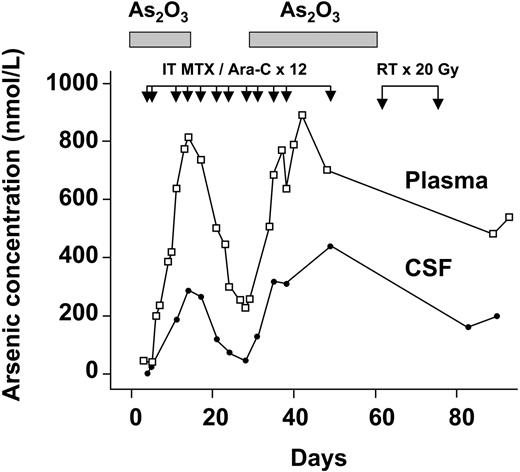Central nervous system (CNS) relapse of acute promyelocytic leukemia (APL) is increasingly reported after treatment with all-trans retinoic acid (ATRA).1 The optimal therapy for these cases remains unclear. Arsenic trioxide (As2O3) is highly effective in marrow APL relapse, but its efficacy in CNS leukemia is undefined. The treatment of a patient with isolated meningeal APL relapse gave us the unique opportunity of documenting CNS penetration of As2O3.
A 52-year-old man developed APL 12 years ago, and achieved a complete remission (CR) after treatment with ATRA, daunorubicin, and cytarabine. After 8 years, a first relapse (R1) occurred. Treatment with oral As2O3 and idarubicin2 for leukocytosis (white blood cell [WBC] count, 65 × 109/L) led to CR2. This was consolidated with idarubicin and maintained with oral As2O3. R2 occurred 20 months later, and CR3 was achieved with combined oral As2O3 and ATRA,3 supplemented by mitoxantrone for leukocytosis (WBC count, 22 × 109/L). Maintenance oral As2O3 and ATRA were administered.
Eighteen months after CR3, the patient presented with severe headache. The cerebrospinal fluid (CSF) showed abundant APL blasts. The radiologic features have been briefly described elsewhere.4 Marrow examination was normal. He was treated with combined oral As2O3 (10 mg/day), ATRA (70 mg/day), and ascorbic acid (1 g/day), as well as intrathecal methotrexate (12 mg/dose) and cytarabine (50 mg/dose). The CSF was gradually normalized. Cranial irradiation (20 Gy) was given. An insidious deterioration of memory and cognitive function ensued, and a computerized tomographic scan showed extensive leukoencephalopathy, which on biopsy showed reactive gliosis with no evidence of leukemic infiltration. He was maintained on oral As2O3, ATRA, and ascorbic acid. At the latest follow-up, 6 months after R4, he remained in remission, with undetectable PML-RARA in peripheral blood and the CSF.
Elemental arsenic levels in the CSF and plasma. Derangement of liver function led to a temporary cessation of As2O3 therapy for 15 days. IT indicates intrathecal; MTX, methotrexate; Ara-C, cytarabine; and RT, cranial radiotherapy.  indicates duration of As2O3 therapy; arrows indicate times of doses.
indicates duration of As2O3 therapy; arrows indicate times of doses.
Elemental arsenic levels in the CSF and plasma. Derangement of liver function led to a temporary cessation of As2O3 therapy for 15 days. IT indicates intrathecal; MTX, methotrexate; Ara-C, cytarabine; and RT, cranial radiotherapy.  indicates duration of As2O3 therapy; arrows indicate times of doses.
indicates duration of As2O3 therapy; arrows indicate times of doses.
Elemental arsenic level was measured in the CSF and in peripheral blood by inductively coupled plasma mass spectroscopy.5 There was significant penetration of arsenic into the CSF, correlating well with plasma levels (Figure 1).
Since the choroid plexus prevents the entrance of heavy metals into the CSF, it has previously been unknown if As2O3 may enter the CNS. In our case, although maintenance As2O3 prevented marrow recurrence, CNS relapse still occurred. This implied that As2O3 had not efficiently penetrated the CNS when the choroid plexus was intact. However, in meningeal leukemia, which might constitute an anatomical/functional breach of the blood-brain barrier, we showed clearly that As2O3 did enter the CSF at significant therapeutic concentrations.
Our observations have important therapeutic implications for CNS APL. Because of the initial uncertainty whether arsenic could enter the CNS, we treated our patient conventionally with intensive intrathecal chemotherapy and irradiation. In hindsight, the combined use of chemotherapy and radiotherapy might have led to the progressive cognitive deterioration. Given that arsenic penetrated the CSF very well, it might have been possible for us to use a less intensive regimen of intrathecal chemotherapy and irradiation. Because the prognosis of relapsed APL remains very good, the appropriate use of treatment with minimal toxicity commensurate with long-term survival is an important priority. Our results suggest that As2O3 may be a valid treatment for meningeal APL. Therefore, the combination of As2O3 with the optimal use of chemotherapy and irradiation in CNS APL needs to be carefully redefined.
Conflict of interest: The University of Hong Kong holds a provisional patent for the use of oral arsenic trioxide in the treatment of leukemia.
The provision of oral arsenic trioxide was supported by the S. K. Yee Medical Foundation.


This feature is available to Subscribers Only
Sign In or Create an Account Close Modal